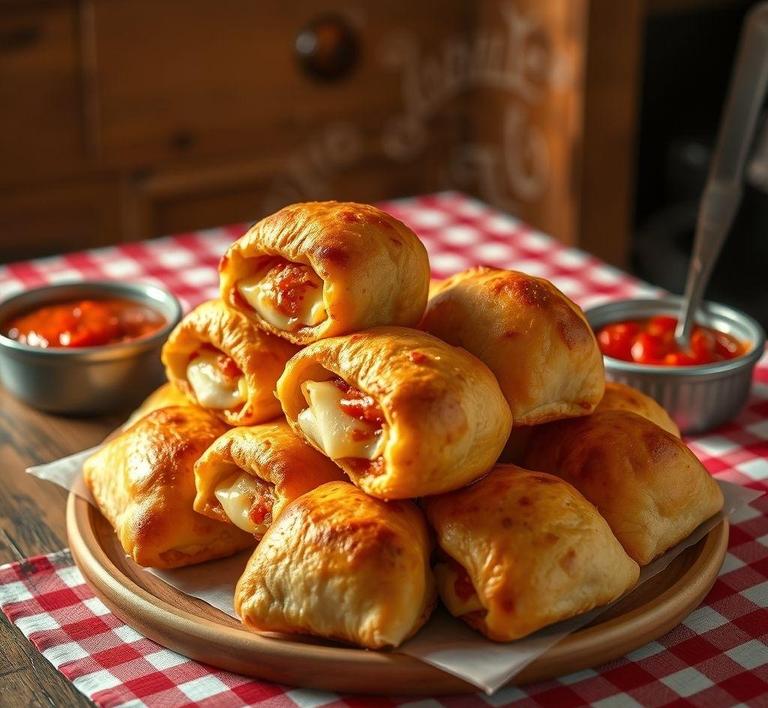If you’ve ever found yourself with leftover pizza rolls after a snack attack, you might be wondering if you can refreeze them without ruining their taste or texture. Well, you’re in luck! Refreezing pizza rolls can be done safely, but there are a few important steps to ensure they stay as delicious as the first time you had them. Whether you’ve cooked too many or just want to save some for later, this guide will walk you through everything you need to know to preserve the flavor and quality of your pizza rolls, so you can enjoy them again without any sogginess or freezer burn.
Can You Refreeze Pizza Rolls?

Pizza rolls, those small, savory snacks filled with melty cheese, pepperoni, and a variety of other ingredients, are a beloved quick bite for many. However, one question that often arises after they’ve been cooked, or even after they’ve been partially thawed, is whether it’s safe or advisable to refreeze pizza rolls. The answer isn’t as straightforward as you might think, as there are several factors to consider.
Refreezing pizza rolls generally refers to the practice of freezing the rolls after they’ve already been thawed or cooked. For pizza rolls that have been completely thawed, you can technically refreeze them, but there are several risks involved. The primary concern is food safety. When food is thawed and refrozen, there is a possibility of bacteria growth, which can lead to foodborne illnesses. In particular, if the pizza rolls have been kept at an unsafe temperature (above 40°F or 4°C) for too long during the thawing process, harmful bacteria such as Salmonella or E. coli may start to grow.
However, if your pizza rolls have only been thawed in the refrigerator and haven’t been sitting at room temperature for more than two hours, they can be safely refrozen. The refrigerator maintains a temperature low enough to prevent bacteria from multiplying, which lowers the risk of foodborne illness. This is particularly important when considering refreezing frozen pizza rolls that have never been fully cooked.
For cooked pizza rolls, the process is slightly different. Once they’ve been baked and allowed to cool, you can technically refreeze them, but only if they haven’t been left out too long. After cooking, pizza rolls should be cooled within two hours and stored in an airtight container or sealed freezer bag to prevent moisture and freezer burn. If you’ve followed these guidelines, refreezing cooked pizza rolls becomes a less risky proposition.
How To Refreeze Pizza Rolls?
If you’ve decided to refreeze your pizza rolls, there are a few steps to follow to ensure they retain as much of their flavor and texture as possible. Refreezing pizza rolls is less straightforward than the initial freezing process, but if done properly, you can preserve their quality for a longer period. Here’s a detailed guide on how to do it:
- Cool the Pizza Rolls Completely: If they’ve already been cooked, allow them to cool completely before attempting to refreeze. This helps prevent condensation, which could lead to ice crystals forming inside the pizza rolls. Ice crystals can affect the texture and make them soggy when reheated.
- Use Airtight Packaging: The key to maintaining the quality of refrozen pizza rolls is airtight storage. If you’re using a freezer bag, make sure to press out as much air as possible. Alternatively, you can use a vacuum-sealed bag to ensure no air remains in contact with the rolls. This will help prevent freezer burn, which can make your pizza rolls dry and flavorless.
- Label and Date: It’s always a good idea to label the packaging with the date you’re freezing them. This way, you can keep track of how long they’ve been in the freezer and ensure they’re consumed within a safe timeframe.
- Freeze Promptly: Once your pizza rolls are packaged securely, place them back in the freezer immediately. Don’t leave them sitting at room temperature, as it increases the risk of bacterial growth. Ensure that the freezer temperature is set at 0°F (-18°C) or lower to keep the pizza rolls at a safe and consistent temperature.
- Consider Partial Freezing: If you don’t want the pizza rolls to stick together when you refreeze them, you can freeze them on a baking sheet first. Lay them out in a single layer, making sure they aren’t touching each other, and place the sheet in the freezer for a couple of hours. Once they’re partially frozen, transfer them to a sealed container or freezer bag. This method is ideal for keeping the pizza rolls separate, making it easier to grab just a few when needed.
- Thawing & Reheating: When you’re ready to eat your refrozen pizza rolls, there’s no need to thaw them. You can go straight to reheating them, either in an oven or microwave, from their frozen state. However, reheating in the oven tends to preserve the original texture better than microwaving. For best results, bake them at 375°F (190°C) for 10-12 minutes, or until they’re crispy and heated through.
Quality Impact
Refreezing pizza rolls can have an impact on their quality, particularly when it comes to taste and texture. Here’s a deeper look into how these factors are affected:
- Texture: The texture of pizza rolls after being refrozen and reheated can often be disappointing. The dough, which was once crispy and golden, might become slightly soggy or chewy. This is because moisture from the filling can escape during the initial freezing and cooking process, and when refrozen, this moisture can cause the outer dough to lose its original crispiness. When reheated, this can lead to a less-than-ideal texture.
- Flavor: While the flavor of the pizza rolls may not drastically change after being refrozen, there can be some degradation. Refreezing causes the ingredients inside the pizza rolls to break down slightly. This means the cheese might not melt quite as well, or the flavor of the sauce and toppings could become a bit muted. However, if you take care to store them properly, the taste can still remain reasonably intact.
- Freezer Burn: One of the biggest risks when refreezing pizza rolls is freezer burn, a condition that occurs when air comes in contact with the food, causing dehydration and oxidation. If your pizza rolls are exposed to air during the refreezing process, they can develop an unpleasant taste and texture, becoming dry and unappetizing. To prevent this, it’s essential to package the rolls tightly and ensure no air remains in the bag or container.
- Moisture Loss: Since pizza rolls contain sauce, cheese, and meat, they are susceptible to moisture loss. When pizza rolls are thawed and refrozen, some of this moisture evaporates, which can result in the dough becoming dry or brittle. This is especially true if you don’t allow them to cool properly before refreezing, as the trapped steam will condense and create ice crystals that negatively affect the quality.
- Bacteria Risk: Though not a direct impact on quality in terms of taste or texture, the risk of bacteria growth is a crucial factor to consider. Refreezing pizza rolls that have been kept at unsafe temperatures or stored improperly can introduce bacteria that could compromise both the flavor and safety of the food.
While you can refreeze pizza rolls, it requires some caution. The primary concern when refreezing is food safety, as improperly handled pizza rolls can lead to bacterial growth or freezer burn. However, if you follow the proper steps-ensuring the rolls are stored airtight, frozen quickly, and consumed within a reasonable time frame-the taste and texture degradation can be minimized.
Ultimately, while refreezing pizza rolls is possible, it is best to avoid it if you can. The best practice is to only thaw and cook as many pizza rolls as you intend to eat. But if you must refreeze, following the proper procedures will help preserve the flavor and ensure the process remains as safe as possible. Enjoy your pizza rolls in their prime state, fresh out of the freezer!
Is It Safe To Refreeze Pizza Rolls?
When it comes to refreezing food, there are many factors to consider to ensure both safety and quality. With pizza rolls, the question of whether it’s safe to refreeze them typically revolves around the potential risks associated with bacterial growth and the degradation of flavor and texture. In general, it is not recommended to refreeze pizza rolls if they have already been thawed and heated.
Pizza rolls are generally frozen to preserve their freshness, and once you defrost and cook them, you introduce the possibility of bacteria multiplying. Bacteria such as Salmonella and E. coli thrive at temperatures between 40°F and 140°F (known as the "danger zone"), and each time the food enters that zone, you risk foodborne illness if it’s not handled properly. If you refreeze pizza rolls after they’ve been cooked or defrosted, the chances of bacterial contamination increase, making the refreezing process potentially unsafe.
However, if the pizza rolls were only thawed (not heated) and have been kept in the refrigerator at a constant temperature below 40°F, they can be safely refrozen. This is because the bacteria won’t have had the opportunity to multiply at unsafe levels, and freezing them again would stop the growth process. But once they are cooked, refreezing is a different story-regardless of how safely you think they’ve been stored.
In addition to food safety concerns, you must also consider how refreezing affects the texture and flavor. Freezing and thawing pizza rolls multiple times can cause them to become soggy or mushy, and their crispy exterior may suffer in the process.
Signs That Pizza Rolls Should Not Be Refrozen
Knowing when pizza rolls should not be refrozen is crucial for both safety and quality. Here are some telltale signs that your pizza rolls may have gone past their refreezing point:
-
They’ve Been Left at Room Temperature for Too Long
If pizza rolls have been sitting out for over 2 hours (or 1 hour if the room temperature exceeds 90°F), they should not be refrozen. Bacteria can multiply rapidly in that time, making it unsafe to refreeze or consume them.
-
Changes in Texture or Appearance
If the pizza rolls appear discolored, mushy, or soggy after defrosting, that’s a sign that refreezing may not be the best option. The texture and structure of the rolls have been compromised, and they likely won’t come out as appetizing once refrozen and reheated.
-
Unpleasant Smell
A sour, off, or unusual odor is a clear indicator that the pizza rolls have spoiled. Smell is one of the easiest and most reliable ways to detect food safety issues. If your pizza rolls smell bad, they should definitely not be refrozen, as bacteria have likely already begun to grow.
-
Improper Storage
If the pizza rolls were not stored properly during the defrosting or thawing process, such as being left uncovered or stored in an unsealed container, they should not be refrozen. Exposure to air can lead to freezer burn, making the texture unpleasant and the taste lacking.
-
They Were Already Refrozen Once
Refreezing food multiple times, especially once it’s been thawed and cooked, can cause it to lose quality and even become unsafe. Pizza rolls that have already undergone a thawing, cooking, and refreezing cycle should be discarded rather than refrozen again.
Common Refreezing Mistakes
Refreezing pizza rolls or any frozen food comes with a series of common mistakes that people make, often out of convenience or misunderstanding. These missteps can lead to food safety issues, poor texture, and unpleasant eating experiences. Here are some of the most common refreezing mistakes:
-
Not Properly Wrapping or Sealing
After defrosting, if the pizza rolls are not tightly wrapped or stored in an airtight container, they will be exposed to moisture and air, which can promote bacterial growth. This improper storage makes refreezing a risky practice, as it can compromise the food’s safety and lead to freezer burn.
-
Refreezing After Cooking
As mentioned earlier, once pizza rolls are cooked, they should not be refrozen. Cooking introduces moisture into the rolls, and when refrozen, the water molecules can rupture the cellular structure, making the dough soggy and unappetizing when reheated.
-
Thawing Pizza Rolls on the Counter
One of the most dangerous mistakes is leaving pizza rolls to thaw on the counter at room temperature for an extended period. Bacteria can grow rapidly in this situation. It’s always safer to thaw frozen pizza rolls in the refrigerator, where the temperature stays below the danger zone.
-
Not Labeling Refrozen Food
Labeling refrozen food is often overlooked, but it’s important for tracking how many times the food has been thawed and refrozen. Without proper labeling, it’s easy to forget how long the food has been sitting in the freezer and whether it’s safe to consume. For safety and quality, label the refrozen pizza rolls with the date they were originally frozen.
-
Using the Same Freezer Bag or Container
Reusing the same bag or container for pizza rolls that were previously defrosted is a common mistake. If the rolls were thawed in a bag and you want to refreeze them, you should transfer them into a fresh, clean bag to avoid contamination from any leftover moisture or food particles.
Tips And Tricks
Although refreezing pizza rolls is not always advisable, there are some tips and tricks that can help you get the best results when freezing, storing, and reheating them:
-
Freeze Pizza Rolls Before Cooking
If you want to refreeze pizza rolls, it’s best to do so before cooking. This allows you to preserve their original quality. Place the uncooked rolls in a single layer on a baking sheet and freeze them. Once they are solid, transfer them to an airtight container or freezer bag for long-term storage.
-
Reheat Properly
When reheating frozen pizza rolls, make sure to cook them evenly. Use an oven or air fryer to get a crispy texture, rather than microwaving, which tends to make them soggy. If you’re reheating previously frozen and cooked pizza rolls, place them on a baking sheet and reheat at 375°F for 10-15 minutes, checking regularly for crispness.
-
Proper Thawing
Thaw pizza rolls slowly in the refrigerator for best results. If you’re in a hurry, you can microwave them, but be sure to cook them immediately afterward to avoid bacteria growth.
-
Avoid Refreezing After Cooking
While you can refreeze uncooked pizza rolls, avoid doing so once they’ve been cooked. If you’ve made extra pizza rolls and are unsure if you’ll be able to eat them all, consider storing the leftovers in the fridge instead. They will last 3-4 days when properly stored.
-
Use Vacuum Sealing for Long-Term Freezing
If you’re looking to freeze pizza rolls for a longer period, invest in a vacuum sealer. It removes air from bags, which helps to prevent freezer burn and preserve the quality of your food. This is a great way to freeze uncooked pizza rolls in bulk for future use.
Conclusion
While refreezing pizza rolls is possible under certain conditions, it’s a practice fraught with risks. If you’re ever in doubt about whether it’s safe to refreeze, always err on the side of caution. Refreezing after cooking is not recommended due to safety concerns and the potential for a disappointing eating experience with soggy, bland pizza rolls. By freezing them before cooking, storing them properly, and adhering to safe thawing and reheating methods, you can ensure that your pizza rolls maintain both safety and quality. So, the next time you find yourself with leftover pizza rolls, consider your options carefully-your stomach (and your health) will thank you!


